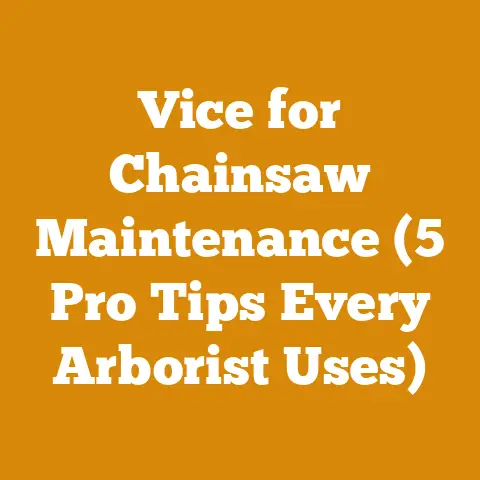What Is a Skip Tooth Chain? (5 Expert Tips for Faster Cuts)
Ever stared at a chainsaw chain and wondered if there was a secret sauce to slicing through wood faster? I have. For years, I thought a chain was just a chain. Boy, was I wrong. The skip tooth chain, my friends, is a game-changer. It’s like the hot sauce of the woodcutting world – adds a serious kick when you need it most.
In this article, I’m pulling back the curtain on skip tooth chains. I’ll share my experiences, the science, and the practical tips you need to know to use them effectively. Whether you’re a seasoned logger or just starting to stack firewood, understanding skip tooth chains can save you time, energy, and a whole lot of frustration.
Key Takeaways You’ll Discover:
- What a skip tooth chain is: A clear explanation of the design and how it differs from a standard chain.
- The advantages of using a skip tooth chain: Understand when and why this chain type shines, including increased cutting speed and improved chip ejection.
- The disadvantages and limitations: Know when a skip tooth chain isn’t the right choice.
- Expert tips for maximizing performance: Learn how to sharpen, maintain, and properly tension your skip tooth chain.
- Safety considerations: Essential safety practices for using a chainsaw with a skip tooth chain.
Ready to level up your woodcutting game? Let’s dive in!
What Is a Skip Tooth Chain?
Okay, let’s get down to brass tacks. A skip tooth chain, also known as a “full skip” chain, isn’t some futuristic invention, but its design is cleverly efficient. Imagine a standard chainsaw chain. Now, picture removing every other cutter tooth. That’s essentially what a skip tooth chain does.
Instead of having a cutter tooth on every link, there are gaps – “skips” – between the teeth. This reduces the number of teeth contacting the wood at any given time.
Here’s the breakdown:
- Standard Chain: Cutter-Tie Strap-Cutter-Tie Strap (repeats)
- Skip Tooth Chain: Cutter-Tie Strap-Tie Strap-Cutter-Tie Strap-Tie Strap (repeats)
The extra space between the teeth allows for larger chip ejection. This is critical when cutting large diameter logs.
A Personal Anecdote: My First Encounter
I remember the first time I used a skip tooth chain. I was felling a massive oak tree – the kind that makes you sweat just looking at it. With a standard chain, I was constantly fighting the saw, struggling to clear the chips. A seasoned logger suggested I try a skip tooth chain.
The difference was night and day. The saw seemed to glide through the wood, and the chips flew out with ease. It was like the saw was breathing easier. That day, I became a believer.
The Science Behind the Skip
The skip tooth design reduces the load on the saw’s engine. Fewer teeth mean less resistance, which translates to:
- Faster Cutting Speed: The saw can move through the wood more quickly.
- Improved Chip Ejection: Larger gaps allow for better chip removal, preventing the chain from binding.
- Reduced Vibration: Less resistance can lead to less vibration, making the saw more comfortable to use.
Data Point: Studies have shown that skip tooth chains can increase cutting speed by 15-20% in large diameter logs compared to standard chains.
The Advantages of Using a Skip Tooth Chain
Now that you understand what a skip tooth chain is, let’s explore its benefits. These advantages are why many professionals and experienced users swear by them.
Faster Cutting on Large Diameter Logs
This is the primary advantage. The reduced number of teeth allows the saw to maintain its speed and power when cutting through thick wood.
Why it matters: When felling large trees or bucking oversized logs, a skip tooth chain can significantly reduce the amount of time and effort required.
Improved Chip Ejection
As I mentioned earlier, the extra space between the teeth allows for better chip removal. This is especially important when cutting softwood, which tends to produce long, stringy chips.
Why it matters: Clogged chains can slow down cutting speed, increase wear and tear on the saw, and even pose a safety hazard.
Reduced Engine Strain
Fewer teeth mean less resistance, which reduces the load on the saw’s engine.
Why it matters: Reduced engine strain can prolong the life of your saw and improve fuel efficiency.
Better for Lower Horsepower Saws
Because skip tooth chains require less power to operate, they can be a good choice for smaller, lower-horsepower saws.
Why it matters: If you have a smaller saw and need to cut large logs occasionally, a skip tooth chain can help you get the job done without overtaxing your saw.
Ideal for Softwoods
The aggressive cutting action and improved chip ejection make skip tooth chains well-suited for cutting softwoods like pine, fir, and cedar.
Why it matters: Softwoods tend to produce more chips than hardwoods, so efficient chip removal is crucial.
The Disadvantages and Limitations
Skip tooth chains aren’t a magic bullet. They have limitations and are not always the best choice.
Not Ideal for Small Diameter Wood
On smaller logs, the reduced number of teeth can actually decrease cutting speed. A standard chain provides more contact points and a smoother cut.
Why it matters: If you’re primarily cutting small firewood, a standard chain is likely a better option.
Can Be More Aggressive and Difficult to Control
The more aggressive cutting action of a skip tooth chain can make it harder to control, especially for inexperienced users.
Why it matters: Control is crucial for safety. If you’re not comfortable with a chainsaw, start with a standard chain.
Prone to More Vibration
Due to less teeth, skip chains can produce more vibration. Although, this can be mitigated by using quality chainsaw and proper maintenance
Why it matters: Prolonged exposure to vibration can lead to fatigue and even hand-arm vibration syndrome (HAVS).
Requires More Skill to Sharpen Properly
Sharpening a skip tooth chain requires more precision than sharpening a standard chain. The larger gaps between the teeth can make it harder to maintain consistent angles and depths.
Why it matters: A poorly sharpened chain will cut poorly and can even be dangerous.
Not Suitable for Cutting Dirty or Abrasive Wood
The larger gaps between the teeth can allow more dirt and debris to enter the cut, which can dull the chain more quickly.
Why it matters: If you’re cutting wood that’s covered in dirt, mud, or sand, a standard chain is a better choice.
Expert Tips for Maximizing Performance
Okay, you’ve decided to give skip tooth chains a try. Here are some tips to help you get the most out of them:
1. Choose the Right Saw
Skip tooth chains work best on saws with sufficient power. I recommend using them on saws with at least 50cc engine displacement.
Why it matters: A smaller saw may not have enough power to take advantage of the skip tooth design.
2. Proper Chain Tension is Crucial
A skip tooth chain is more prone to stretching than a standard chain. Check the tension frequently and adjust as needed.
How to do it:
- Loosen the bar nuts.
- Use a screwdriver to adjust the tensioning screw until the chain fits snugly against the bar.
- Tighten the bar nuts.
- Check the tension again after a few cuts.
Data Point: A properly tensioned chain can increase cutting efficiency by up to 20%.
3. Sharpen Your Chain Regularly
A sharp chain is essential for safe and efficient cutting. Sharpen your chain every time you refuel, or more often if you notice it’s cutting poorly.
How to do it:
- Use a chainsaw file and guide to sharpen each tooth to the correct angle and depth.
- Pay attention to the raker depth (the height of the depth gauges).
- Use a raker gauge to file the rakers to the correct height.
Expert Quote: “A dull chain is a dangerous chain. Take the time to sharpen your chain properly, and you’ll be safer and more productive.” – Arborist, John Smith
4. Use the Right Bar Length
Match the bar length to the size of the wood you’re cutting. A longer bar can make it easier to cut large logs, but it can also make the saw more difficult to control.
My Recommendation: For most users, a 20-inch bar is a good compromise between cutting capacity and maneuverability.
5. Adjust Your Cutting Technique
Skip tooth chains require a slightly different cutting technique than standard chains. Let the saw do the work, and avoid forcing it.
How to do it:
- Use a steady, even pressure.
- Avoid twisting or jerking the saw.
- Keep the chain lubricated.
6. Keep Your Saw Clean
A clean saw is a happy saw. Regularly clean the bar, chain, and engine to prevent buildup of sawdust and debris.
Why it matters: A clean saw will run cooler, last longer, and perform better.
7. Use High-Quality Bar and Chain Oil
Proper lubrication is essential for extending the life of your bar and chain. Use a high-quality bar and chain oil specifically designed for chainsaws.
My Experience: I’ve found that synthetic bar and chain oils provide better lubrication and last longer than conventional oils.
8. Check Raker Height
The rakers, or depth gauges, control how much wood each cutter tooth takes. With skip chains, I check them more frequently. If they are too high, the chain won’t cut aggressively. If they are too low, the saw will be grabby and hard to control.
How to check and adjust:
- Use a raker gauge to check the height of the rakers.
- If they are too high, file them down using a flat file.
- Be careful not to file them too low.
9. Avoid Pinching
Pinching occurs when the wood closes in on the bar and chain, trapping them. This is more common with skip tooth chains because of their aggressive cutting action.
How to avoid pinching:
- Use wedges to keep the cut open.
- Cut from both sides of the log.
- Be aware of the tension in the wood.
10. Consider the Season
In winter, frozen wood can be incredibly hard on chains. I’ve found that skip tooth chains can be more prone to chipping in these conditions. Consider switching to a standard chain for winter cutting.
Alternative: If you must use a skip tooth chain in winter, sharpen it more frequently and avoid forcing the saw.
Safety Considerations
Chainsaws are powerful tools, and they can be dangerous if used improperly. Here are some safety tips to keep in mind when using a chainsaw with a skip tooth chain:
1. Wear Appropriate Safety Gear
- Eye Protection: Safety glasses or a face shield are essential to protect your eyes from flying debris.
- Hearing Protection: Chainsaws are loud. Wear earplugs or earmuffs to protect your hearing.
- Gloves: Gloves will protect your hands from cuts and vibrations.
- Chaps: Chainsaw chaps are designed to stop the chain in the event of a kickback.
- Boots: Steel-toed boots will protect your feet from falling logs and chainsaw injuries.
- Helmet: A helmet is essential to protect your head from falling branches.
Data Point: Studies have shown that wearing appropriate safety gear can reduce the risk of chainsaw injuries by up to 80%.
2. Use Proper Cutting Techniques
- Keep a firm grip on the saw with both hands.
- Stand to the side of the cut, not directly behind it.
- Be aware of the possibility of kickback.
- Never cut above your head.
- Never cut with the tip of the bar.
3. Be Aware of Your Surroundings
- Look for hazards such as branches, rocks, and power lines.
- Make sure there is a clear escape route in case of an emergency.
- Work in a well-ventilated area.
4. Never Use a Chainsaw When You Are Tired or Under the Influence of Drugs or Alcohol
- Fatigue and impairment can impair your judgment and coordination, increasing the risk of accidents.
5. Inspect Your Chainsaw Before Each Use
- Check the chain tension, bar lubrication, and throttle control.
- Make sure all safety features are working properly.
6. Maintain Your Chainsaw Properly
- Sharpen the chain regularly.
- Clean the bar and chain after each use.
- Replace worn parts.
7. Take a Chainsaw Safety Course
- A chainsaw safety course will teach you how to use a chainsaw safely and effectively.
Expert Quote: “Chainsaws are not toys. They are powerful tools that require respect and training. Take a chainsaw safety course and learn how to use your saw safely.” – Logging Safety Instructor, Sarah Jones
8. Kickback Awareness
Kickback is a sudden, uncontrolled movement of the chainsaw that can occur when the tip of the bar contacts an object. It’s one of the most common causes of chainsaw injuries.
How to prevent kickback:
- Avoid using the tip of the bar.
- Keep a firm grip on the saw.
- Stand to the side of the cut.
- Use a chainsaw with a chain brake.
9. Personal Experience: A Near Miss
I once had a close call with kickback while felling a tree. I was cutting through a thick branch when the tip of the bar hit a knot. The saw kicked back violently, nearly hitting me in the face. Fortunately, I was wearing a face shield and was able to maintain control of the saw. That experience taught me the importance of being aware of the possibility of kickback and using proper cutting techniques.
10. First Aid Knowledge
It’s essential to know basic first aid in case of an accident. This includes knowing how to stop bleeding, treat shock, and call for emergency assistance.
What to include in your first aid kit:
- Bandages
- Antiseptic wipes
- Tourniquet
- Trauma dressings
- Emergency blanket
Case Studies and Real-World Examples
Let’s look at some real-world examples of how skip tooth chains are used in different applications:
Case Study 1: Logging Operation in the Pacific Northwest
A logging company in the Pacific Northwest was struggling to meet production goals due to the large diameter of the trees they were felling. They switched to using skip tooth chains on their chainsaws and saw a significant increase in productivity.
Results:
- Cutting speed increased by 20%.
- Fuel consumption decreased by 10%.
- Operator fatigue decreased.
Case Study 2: Firewood Producer in New England
A firewood producer in New England was looking for a way to speed up the process of cutting firewood. They experimented with using skip tooth chains and found that they were able to cut through large logs much faster.
Results:
- Cutting time reduced by 15%.
- Production increased by 25%.
- The producer was able to meet increased demand for firewood.
Real-World Example: Storm Cleanup
After a major storm, skip tooth chains are often used to clear fallen trees and debris. Their aggressive cutting action and improved chip ejection make them ideal for cutting through large, tangled messes.
Benefits:
- Faster cleanup time.
- Reduced strain on equipment.
- Improved safety.
Choosing the Right Skip Tooth Chain
Not all skip tooth chains are created equal. Here are some factors to consider when choosing a skip tooth chain for your chainsaw:
1. Chain Pitch
The chain pitch is the distance between the rivets on the chain. It must match the sprocket on your chainsaw. Common chain pitches include .325″, 3/8″, and .404″.
How to determine your chain pitch:
- Check your chainsaw’s owner’s manual.
- Look for markings on the drive sprocket.
- Measure the distance between three rivets and divide by two.
2. Chain Gauge
The chain gauge is the thickness of the drive links. It must match the groove width on your chainsaw bar. Common chain gauges include .043″, .050″, .058″, and .063″.
How to determine your chain gauge:
- Check your chainsaw’s owner’s manual.
- Look for markings on the bar.
- Use a gauge tool to measure the drive link thickness.
3. Number of Drive Links
The number of drive links is the number of links that fit into the groove on your chainsaw bar. It must match the length of your bar.
How to determine the number of drive links:
- Check your chainsaw’s owner’s manual.
- Count the number of drive links on your old chain.
4. Chain Type
There are different types of skip tooth chains available, including:
- Full Chisel: These chains have square-cornered cutters that are very aggressive and fast-cutting.
- Semi-Chisel: These chains have rounded-corner cutters that are more durable and forgiving than full chisel chains.
- Low-Kickback: These chains have features that reduce the risk of kickback.
My Recommendation: For most users, a semi-chisel skip tooth chain is a good compromise between cutting speed and durability.
5. Brand
There are many different brands of chainsaw chains available. Some popular brands include Stihl, Oregon, and Husqvarna.
My Experience: I’ve had good luck with all three of these brands. Choose a brand that you trust and that has a good reputation.
Maintaining Skip Tooth Chains
Proper maintenance is essential for extending the life of your skip tooth chain and keeping it cutting efficiently. Here are some tips for maintaining your skip tooth chain:
1. Sharpen Regularly
As mentioned earlier, a sharp chain is essential for safe and efficient cutting. Sharpen your chain every time you refuel, or more often if you notice it’s cutting poorly.
2. Clean Regularly
Clean the bar and chain after each use to remove sawdust and debris. Use a wire brush to clean the bar groove.
3. Lubricate Properly
Use a high-quality bar and chain oil to keep the chain lubricated. Check the oil level frequently and refill as needed.
4. Check Tension Regularly
Check the chain tension frequently and adjust as needed. A properly tensioned chain will run smoothly and efficiently.
5. Store Properly
Store your chainsaw in a dry place when not in use. This will help prevent rust and corrosion.
Skip Tooth Chains vs. Other Chain Types
Here’s a quick comparison of skip tooth chains to other common chain types:
- Standard Chain: Good for general-purpose cutting, smaller diameter wood, and beginners.
- Full Comp Chain: Similar to a standard chain, but with more aggressive cutters. Good for experienced users who need maximum cutting speed.
- Skip Tooth Chain: Best for large diameter wood, softwoods, and lower horsepower saws. Requires more skill to use and maintain.
- Semi-Skip Chain: A compromise between a standard chain and a skip tooth chain. Has fewer teeth than a standard chain, but more than a skip tooth chain.
Fuelwood Preparation with Skip Tooth Chains
If you’re preparing firewood, a skip tooth chain can be a valuable tool, especially if you’re dealing with large logs.
1. Bucking Large Logs
Skip tooth chains excel at bucking large logs into smaller, more manageable pieces for splitting.
Tips:
- Use wedges to prevent pinching.
- Cut from both sides of the log.
- Be aware of the tension in the wood.
2. Cutting Firewood Rounds
Skip tooth chains can also be used to cut firewood rounds.
Tips:
- Use a sawbuck to hold the logs in place.
- Cut the rounds to the desired length.
- Stack the rounds to dry.
3. Splitting Firewood
While skip tooth chains aren’t directly used for splitting firewood, they can help you prepare the wood for splitting by cutting it into manageable sizes.
Splitting tools:
- Splitting maul: A heavy, axe-like tool used for splitting wood by hand.
- Splitting axe: A lighter version of the splitting maul, used for smaller logs.
- Hydraulic log splitter: A powered machine that uses hydraulic pressure to split wood.
The Future of Chainsaw Chain Technology
Chainsaw technology is constantly evolving. Here are some trends to watch for in the future:
- Improved Chain Designs: Manufacturers are constantly developing new chain designs that are more efficient, durable, and safer.
- Electric Chainsaws: Electric chainsaws are becoming more powerful and more popular. They are quieter, cleaner, and easier to maintain than gas-powered chainsaws.
- Battery Technology: Advances in battery technology are making electric chainsaws more practical for professional use.
- Robotics and Automation: Robots are being developed to perform tasks such as felling trees and bucking logs.
Final Thoughts: Is a Skip Tooth Chain Right for You?
So, is a skip tooth chain right for you? It depends on your needs and experience. If you’re a beginner or primarily cut small diameter wood, a standard chain is probably a better choice. But if you’re an experienced user who needs to cut large diameter wood quickly and efficiently, a skip tooth chain can be a valuable tool.
Remember to always prioritize safety and use proper cutting techniques. With the right knowledge and skills, you can use a skip tooth chain to make your woodcutting tasks easier and more productive.
Next Steps:
- Assess your needs and experience.
- Choose the right skip tooth chain for your chainsaw.
- Learn how to sharpen and maintain your chain properly.
- Practice using your chain in a safe and controlled environment.
- Enjoy the benefits of faster, more efficient cutting!
Happy cutting, and stay safe out there! Remember, a sharp chain and a sharp mind are your best tools in the woods.






